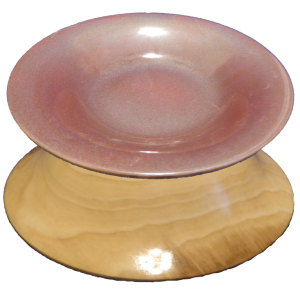Airbrush Acrylic Finish To Enhance Plain Wood Plate
May also be viewed on YouTube – Be better here. 🙂
I started work on this poplar dish to prepare for a airbrush workshop taught by Jay Shepherd at Williamette Valley Woodturners. The poplar is approximately 9″ diameter and 2″ tall. Initially, I finished it with shellac friction polish to seal the wood.
Then at Jay Shepherd’s workshop, he recommended that I paint only the interior of the dish with an iridescent brown acrylic paint with my airbrush. That part was easy. The harder part then is to apply a rattle can clear lacquer and wet sand between every 6 to 10 coats.
I’ve made it thru 220 grit wet sanding and have added new layers but not enough to sand with 400 grit. Sanding is to remove any imperfections and orange peel and build a finish so that the surface reflects like a mirror.
My last sanding will be with 600 grit paper.
For the lacquer spraying, I made a stand to hold the dish while I spray the lacquer.
Good turning.

Alan, Was wondering if your move to Colorado has been completed and that you are set up in your new Wood Shop
Rg,
Sam
Sorry, I’m not setup yet in Lindon Utah. I miss my lathe and turning projects.
Hopefully not much longer.
Alan
Hi: Bet you’ll love Utah!! we love RVing there–beautiful area. Enjoy your new shop–love tour turnings and seeing your videos
Diane
Thank you Diane – there’s a lot more to try.
Alan
Alan, would you supply a bit of info on your method of wet sanding between coats of wet lacquer.
Not a lot to it.
If heavy orange peel then start with wet/dry 220 – after sanding recoat and move to next grit.
For sanding.
– Have a bright light shining on the bowl. I want to see reflection from low areas (valleys between the orange peel)
– wet the sandpaper or the object lightly.
– if holding sandpaper by hand, sand with sideways stroke to have more of the flat of the fingers against the sandpaper.
– Light sideways stokes, constantly changing direction to avoid sanding a channel into the work.
– regularly wipe off residue with wrung out sponge and assess reflection.
– when reflection disappears your either done or into the undercoat – it’s time to recoat.
– if a lot of reflection, then continue sanding.
– if you see color in sanding residue – stop and recoat – you went too far.
– if you get nervous about sanding thru – stop and recoat before you go too far. 🙂
This is an art (tedious art) not a science.
Alan